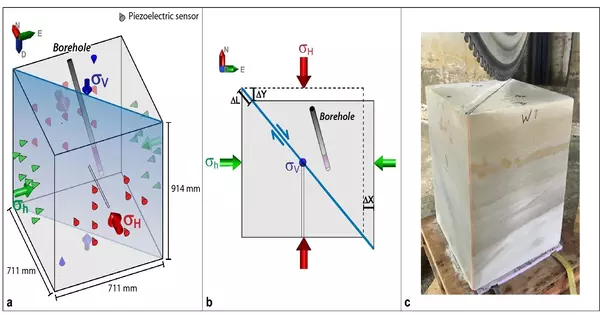A Skoltech professor and his colleagues from the Norwegian Seismic Array and the University of Illinois at Urbana-Champaign, U.S., have run an experiment that reproduces the injection of the greenhouse gas carbon dioxide underground for semi-permanent storage to prevent global climate warming. They have found that, despite some fears, this process does not cause earthquakes if CO2 is injected at the pressures commonly used. The study is published in Scientific Reports.
Carbon storage is one of the pillars of the low-carbon economy, along with the many ways of actually reducing CO2 emissions. The principal ways of binding CO2 are in biomass—e.g., by planting trees—and in deep underground reservoirs, such as depleted oil fields. The latter approach, known as geosequestration, is the subject of much debate due to the perceived potential of pressure-pumped gas to trigger earthquakes.
“Our studies suggest that, as long as we use solid judgment and control the gas pumping pressure, we may safely sink carbon dioxide into deep subsurface rock reservoirs without producing deadly earthquakes,” the researchers write.
Skoltech Professor Sergey Stanchits
“Our experiments show that provided we exercise sound judgment and limit the gas pumping pressure, it is possible to safely sink carbon dioxide into rock reservoirs that are deep underground without causing destructive earthquakes,” study co-author and Skoltech Professor Sergey Stanchits comments.
Both this study, which relied on equipment at Schlumberger U.S., and Stanchits’s ongoing work at Skoltech in Russia, involve experiments with massive cube-shaped rocks that are sawed in half (see photo) to imitate two sides of a geological fault sliding against each other. The cube is pressed on all six sides to simulate the forces driving plate tectonics. Chemically inert silicone oil was injected into the rock to imitate the increase in pore pressure caused by CO2 injection in the field.
“We turned on our improvised plate tectonics by applying uneven pressures to different faces of the sandstone cube, each side measuring about one meter,” Stanchits explains. “The ‘plates’ started slowly creeping against each other, and we could hear them make a faint crackling sound with very sensitive microphones placed on all sides of the cube.”
That in itself, however, constitutes normal seismic activity. “That’s how tectonic plates are, always slowly moving,” the researcher adds. And it never becomes a problem unless they jam for some time. The strain builds up and is then released in an instant. That sudden slip of the fault is the earthquake. “
The team wanted to see if pumping fluid into a borehole that reached relatively close to the fault would trigger something more than a faint crackling—a real earthquake in a lab! But it didn’t. “So we did something you’re not supposed to do in a real-life sequestration project: we had another hole, which went right up to the fault, and that’s where we now injected the fluid under the pressure expected on the Earth during CO2 sequestration,” Stanchits recounts. Still, somewhat disappointingly, the rocks just continued coasting along at the same less-than-catastrophic pace.
So the researchers tweaked the experiment mythbuster-style. “We thought, well, maybe we could use the first hole, the one that terminated 10 centimeters from the fault, but step up the pressure so much as to induce a fracture in the rock,” the scientist says. “This is something you definitely would not want to do in a carbon storage project, but it’s somewhat similar to hydraulic fracturing.” Energy companies do it to get the oil or gas flowing from unconventional reservoirs, but also, potentially, to reach into the planet’s warm depths through the resulting crack and produce renewable geothermal energy.
To cut a long story short, the team had to go all the way up from 45 times the normal atmospheric pressure in the original experiments to as much as 180 atmospheres before the sandstone gave in and a fracture leading right into the fault opened up. “We shut down the injection, the pressure in the wellbore dropped, and for about 10 minutes, things kept quiet.” But as we soon learned, this was the time it took the fluid to get redistributed in the fault zone to the point where, finally, there was quite a noticeable jerk in the previously smooth movement of the plates. “That definitely qualified as a lab earthquake,” Stanchits says, adding that in the field, the earthquake preparation would have probably taken a day or so, if the hydraulic fracturing was performed in close proximity to the fault.
Summing up the findings of this rather exciting experiment, the researcher concludes that carbon sequestration underground at pressures normally considered for the purpose and in properly chosen locations should be safe and should not induce earthquakes and gas seepage into groundwater or back into the atmosphere. Even fracking appears to be safe if done with due regard to the local geology and at a sufficient distance from any fault. The authors of the study believe that similar laboratory experiments are crucial for minimizing both the expenses and the inherent risks of any such geological intervention. “It’s just not something you want to do by trial and error,” Stanchits concludes.
More information: Volker Oye et al, Cubic-meter scale laboratory fault re-activation experiments to improve the understanding of induced seismicity risks, Scientific Reports (2022). DOI: 10.1038/s41598-022-11715-6





